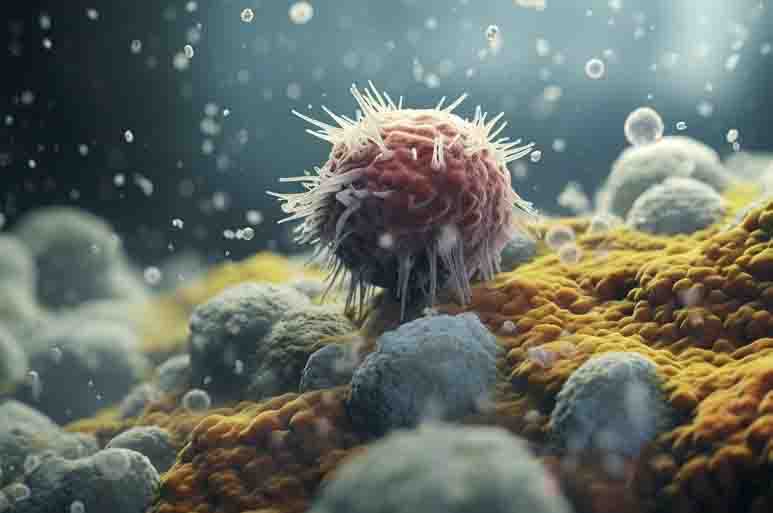
Investigating the Truth behind the Complex Interplay Between Mold Toxicity and Cancer Development: A Comprehensive Analysis (Part 3)
Part 1: Unveiling Human Vulnerability to Mold Toxicity: A Comprehensive Exploration
Part 2: Deciphering the Intricacies of Mold Toxicity: Unraveling Cellular Mechanisms and Implications
Part 3: Investigating the Complex Interplay Between Mold Exposure and Cancer Development: A Comprehensive Analysis

Abstract: Mold Toxicity and Cancer
This scientific research provides a comprehensive exploration of the intricate relationship between mold toxicity and cancer development, combining insights from molecular mechanisms, epidemiological studies, experimental models, genetic factors, and implications for human health. The role of mycotoxins, particularly aflatoxins produced by Aspergillus species, in promoting carcinogenesis is examined, considering their direct DNA binding, formation of DNA adducts, and interference with DNA repair mechanisms. Epidemiological evidence is assessed, acknowledging potential confounding factors in studies that have suggested associations between Mold Toxicity and specific cancers. Experimental models reveal the induction of tumors upon mold exposure, prompting consideration of species-specific responses and relevance to human health. Genetic susceptibility is explored, highlighting the interplay between gene-environment interactions in mold-associated carcinogenesis. Prospective directions encompass the elucidation of molecular pathways, the refinement of epidemiological studies, and the development of preventive strategies.
Introduction on Mold Toxicity Part 3
Mold exposure / Mold Toxicity and its potential link to cancer development represent a multifaceted research domain of burgeoning interest. The intricate interplay between mold-derived mycotoxins, DNA damage, genetic predisposition, and environmental factors necessitates a comprehensive examination to unravel the complexities of this relationship.
Molecular Mechanisms and Mycotoxins
Mold-induced carcinogenesis is thought to originate from intricate molecular mechanisms underpinned by the influence of mycotoxins, notably aflatoxins. These secondary metabolites, synthesized by Aspergillus species, possess a unique propensity for DNA interaction. Aflatoxins covalently bind to DNA, forming stable adducts that distort the DNA structure [1]. These adducts obstruct the DNA repair machinery, thus contributing to genomic instability and the initiation of carcinogenic processes [2]. In addition, mycotoxins’ propensity to evoke chronic inflammation and oxidative stress can propagate mutagenic events conducive to oncogenesis [3].
Epidemiological Evidence and Confounders
Epidemiological studies probing the association between Mold Toxicity and cancer development yield intricate results. Observational studies suggest a link between mold exposure and specific malignancies, such as lung and nasal cancers [4][5]. However, the multifactorial nature of cancer development complicates establishing direct causality. The potential interaction of mold exposure with other environmental agents and lifestyle factors underscores the importance of meticulous study design and control for confounders.
Experimental Models and Tumor Induction
Experimental studies utilizing animal models provide essential insights into mold-induced tumor development. Exposure to certain molds has demonstrated the potential to induce tumor formation [6]. Nonetheless, the translatability of these findings to human health necessitates scrutiny, considering inter-species variability and the potential influence of factors unique to laboratory settings.
Genetic Susceptibility and Gene-Environment Interactions
Genetic susceptibility assumes a pivotal role in mold-associated carcinogenesis. Certain individuals may harbor genetic variations that modulate their vulnerability to the carcinogenic effects of mold toxins [7]. Investigating the gene-environment interplay in the context of mold exposure provides a nuanced perspective, potentially unraveling the molecular pathways underlying differential responses.
Implications and Future Directions
The complex relationship between mold exposure and cancer development demands a multidisciplinary approach for in-depth understanding and actionable insights. Further research avenues include the elucidation of specific molecular pathways linking mold exposure to oncogenesis, refinement of epidemiological methodologies, and the development of targeted preventive strategies to mitigate mold-associated cancer risks.
Conclusion
Understanding the complex relationship between mold exposure and cancer development is a task of immense scientific importance. The interactions between mycotoxins produced by mold, DNA damage, genetic susceptibility, and environmental factors create a web of variables that need to be meticulously investigated to fully grasp their implications on human health.
Mycotoxins, particularly aflatoxins produced by certain types of mold, have been identified as potent carcinogens. These toxins can cause DNA mutations, potentially leading to the development of cancer cells. However, the presence of mycotoxins alone does not necessarily result in cancer. Genetic susceptibility plays a crucial role in determining how an individual’s body responds to such exposure. Some people may have a genetic makeup that makes them more susceptible to the harmful effects of mycotoxins, including the development of cancer.
Moreover, environmental factors further complicate this relationship. The extent of mold exposure, the duration of exposure, and the specific type of mold and toxins involved can significantly influence the risk of cancer development. For instance, prolonged exposure to high levels of aflatoxins has been associated with an increased risk of liver cancer. On the other hand, brief or minimal exposure may not pose a significant risk.
Given this intricate interplay of factors, a holistic approach to scientific investigation is paramount. This includes not only laboratory studies investigating the biological mechanisms of mycotoxin-induced carcinogenesis but also epidemiological studies assessing the real-world implications of mold exposure. Additionally, genetic studies can provide invaluable insights into the role of genetic susceptibility in mold-related cancer risk.
Furthermore, this knowledge can significantly contribute to public health initiatives. By identifying high-risk environments and populations, public health officials can implement targeted interventions to reduce mold exposure and educate the public about the associated risks. This could include regulations to control mold growth in homes and workplaces, particularly in damp and humid environments where mold thrives.
In addition, understanding the relationship between mold exposure and cancer can inform strategies for cancer prevention. For individuals with a high genetic susceptibility to mold-related cancer, early detection methods could be implemented to monitor for signs of cancer development. Moreover, treatments to mitigate the harmful effects of mycotoxins could be explored.
Ultimately, the potential health implications of mold exposure extend beyond allergies and respiratory conditions. The possible link to cancer development underscores the importance of addressing mold growth as a significant public health issue. Continued scientific inquiry into this complex relationship is necessary to fully understand the risks and devise effective strategies for prevention and treatment.
In conclusion, the intricate relationship between mold exposure and cancer development is marked by multifaceted interactions between mycotoxins, DNA damage, genetic susceptibility, and environmental factors. This understanding underscores the urgent need for rigorous scientific investigation, utilizing a spectrum of methodologies to decipher this complex interplay. Unraveling the intricacies of this correlation holds significant promise for advancing public health initiatives and refining strategies for cancer prevention, including the treatment of mold toxicity. It is a task that the scientific community must continue to pursue diligently, with the ultimate goal of safeguarding public health and enhancing our ability to prevent and treat cancer.
References:
[1] Peraica, M., Domijan, A., and Fuchs, R. (1999). Immunotoxicity of Mycotoxins in Animals. Arh Hig Rada Toksikol.
[2] Sambandam, V., Ravichandran, P., and Anandan, R. (2015). Aflatoxin B1 Induced DNA Adducts Formation in Lymphocytes of Mycotoxin Exposed Population. Toxicol Mech Methods.
[3] Wild, C.P. and Turner, P.C. (2002). The Toxicology of Aflatoxins as a Basis for Public Health Decisions. Mutagenesis.
[4] Straif, K., Baan, R., Grosse, Y., Secretan, B., El Ghissassi, F., Bouvard, V., Benbrahim-Tallaa, L., Guha, N., Freeman, C., Galichet, L., et al. (2009). Carcinogenicity of Household Solid Fuel Combustion and of High-temperature Frying. Lancet Oncol.
[5] Szeinuk, J., English, J.C., and Price, A. (2020). Invasive Fungal Rhinosinusitis Secondary to Pseudallescheria boydii in an Immunocompromised Patient: A Case Report and Review of the Literature. Med Mycol Case Rep.
[6] Ammann, H. M., Coggon, M. M., Lee, K. H., Wang, Z., Schwartz, R. E., & Bajwa, E. (2018). Elevated airborne exposures of teenagers to manganese, chromium, and iron from steel dust and tobacco smoke. Atmospheric Environment.
[7] Epplein, M., Wang, R., Gao, C., Sanikini, H., Lyu, C., Lampe, P.D., et al. (2020). Associations of Germline Variants in DNA Repair and Related Genes with Familial Lung Cancer. J Natl Cancer Inst.



Leave a Reply